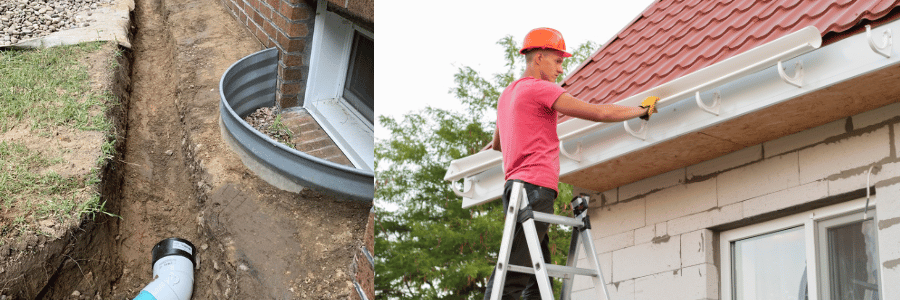Frequent rainfall can take a toll on your home, especially when it comes to your windows. Water can seep into even the smallest gaps around your window frames, leading to a host of problems such as water damage, mold growth, drafts, and reduced energy efficiency. Fortunately, there are several steps you can take to protect your windows from the elements and ensure your home remains dry, comfortable, and energy-efficient.
In this guide, we’ll walk you through the best practices for rain-proofing your windows, from choosing the right materials to maintaining proper sealing and addressing common issues like condensation and mold buildup. With a little attention to detail, you can safeguard your windows against water damage and extend their lifespan.
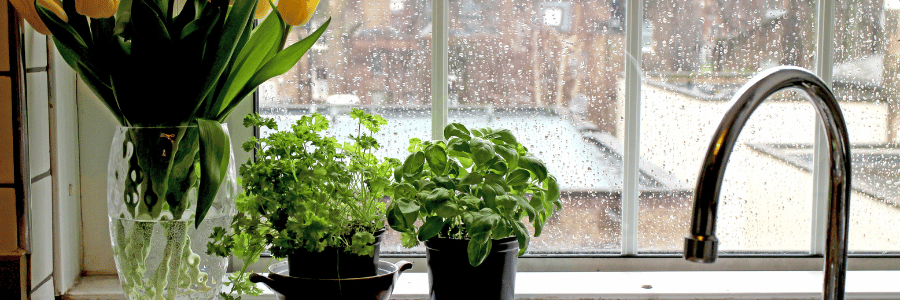
1. Choose Water-Resistant Window Materials
The first line of defense against rain is selecting the right materials for your windows. Different window frame materials have varying degrees of resistance to moisture, so it’s important to choose one that will stand up to the elements and minimize the risk of water damage.
Vinyl Frames
Vinyl windows are an excellent choice for wet climates. They are resistant to moisture and will not warp, rot, or swell like wood can when exposed to water. Vinyl frames are durable and require very little maintenance. Additionally, they are energy-efficient and provide good insulation, keeping your home comfortable during all seasons.
Fiberglass Frames
Fiberglass is another great material for wet weather. It is highly durable and does not expand or contract with moisture like wood or metal frames. Fiberglass windows are also energy-efficient and have a sleek, modern look that suits many home styles.
Aluminum Frames (with Thermal Breaks)
While aluminum frames are durable and resistant to rain, they tend to conduct heat and cold, which can lead to condensation inside the window. If you choose aluminum frames, make sure they have a thermal break—an insulating layer that helps reduce condensation and improve energy efficiency.
Wood Frames (with Proper Treatment)
Wood frames can offer a natural, timeless look, but they are prone to moisture damage unless properly sealed and maintained. If you prefer wood frames, be sure to treat them with a water-resistant finish or stain. Regular maintenance, including re-sealing and painting, will help prevent rot and swelling caused by exposure to rain.
2. Seal Gaps and Cracks
Even the most durable windows can suffer from water intrusion if the seals around the window are compromised. Proper sealing is crucial for rain-proofing your windows and preventing leaks.
Weatherstripping
Weatherstripping is an affordable and effective way to improve the seal around your windows. It prevents drafts and helps keep rain from seeping in through gaps around the window. Over time, weatherstripping can wear out or lose its effectiveness, so it’s important to check and replace it regularly, especially before rainy seasons.
Caulking
Over time, the caulk around your windows can crack or shrink, allowing moisture to enter your home. Inspect the caulking around your windows annually and reapply it as needed. Silicone or polyurethane caulk is best for creating a waterproof seal, as it’s flexible, long-lasting, and resistant to moisture.
Check for Drafts
To check whether your windows are properly sealed, do a simple draft test. On a windy day or using a candle or incense stick, check for flickering or moving smoke around the edges of your window. If you notice drafts or see smoke shifting, it’s time to replace weatherstripping or re-caulk the window.
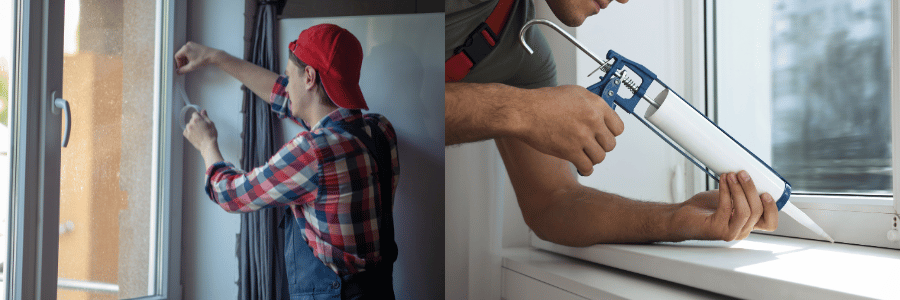
3. Install Proper Flashing
Flashings are thin materials installed around the edges of windows to prevent water from infiltrating the wall behind the window frame. Proper flashing is essential to ensure that rainwater flows away from the window and doesn’t penetrate the wall or foundation of your home.
Metal Flashing
For maximum protection, consider installing metal flashing around your windows. This is particularly effective for areas exposed to heavy rainfall, such as the exterior of your home or windows installed near sloped roofs. Flashing directs rainwater away from the window frame and prevents leaks.
Flashing Tape
Flashing tape is an alternative to metal flashing, providing a waterproof barrier around the window frame. It’s a quick and easy solution that can be applied directly to the frame, sealing it tightly and preventing water from seeping into gaps. Flashing tape works well in conjunction with other water-proofing measures, like caulking and weatherstripping.

4. Maintain Drainage and Window Wells
Proper drainage around your windows is essential for preventing water from pooling near the window frame. Water that collects around your windows can lead to rot, mold, and foundation damage over time. Below are some tips to ensure your windows have good drainage:
Check Window Wells
If you have basement windows or below-ground windows, make sure the window wells are clear of debris and allow water to drain properly. Over time, dirt and leaves can accumulate in window wells, blocking drainage and leading to water backup. You can install a window well cover to keep debris out and ensure proper drainage.
Slope Landscaping Away from Windows
Ensure that the ground surrounding your windows slopes away from the house. If the ground slopes toward your windows, rainwater will flow toward the foundation and window frames, increasing the risk of water infiltration. Use soil or gravel to redirect water away from your windows and foundation.
Install Gutter Guards
Your gutters play a critical role in channeling rainwater away from your home, but clogged gutters can lead to water overflow and leaks around windows. Installing gutter guards or screens can help prevent leaves and debris from clogging the gutters, ensuring rainwater flows freely and doesn’t collect around window frames.
5. Install Storm Windows for Extra Protection
Storm windows provide an extra layer of protection for your existing windows, especially if you live in an area with heavy rain or harsh weather. These windows are installed over your regular windows and create a barrier that helps protect the primary window from water and wind.
Double-Glazed Storm Windows
Double-glazed storm windows can help improve insulation, prevent condensation, and reduce drafts. The added layer of glass helps prevent rainwater from reaching the inner window while also providing additional thermal protection. This is a good option for homes with older, single-pane windows.
Exterior Storm Windows
These are typically installed on the outside of your primary window and can be made of glass or acrylic. Exterior storm windows are particularly effective in protecting against rain, reducing the likelihood of water infiltration into the window frame.
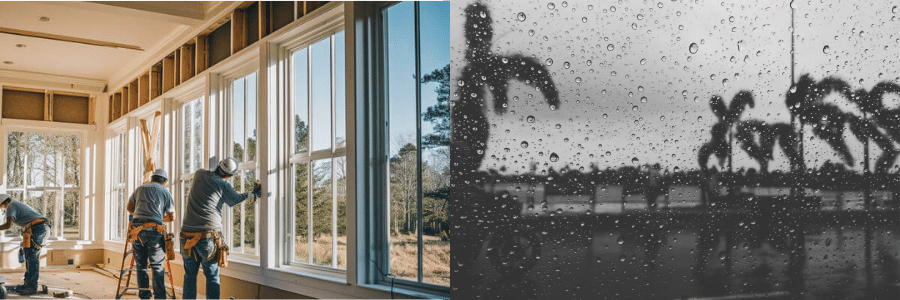
6. Address Condensation Issues
Condensation is a common issue in areas with high humidity or temperature fluctuations. It forms when warm, moist air meets the cooler surface of the window glass. Condensation can contribute to mold growth and water damage if not addressed properly.
Use a Dehumidifier
If you experience excessive condensation on your windows, a dehumidifier can help reduce the humidity in the air and minimize moisture buildup. Keeping the indoor humidity levels in check can also reduce the likelihood of mold growth and water damage around your windows.
Ventilation
Proper ventilation in your home is key to preventing condensation. Use exhaust fans in bathrooms and kitchens, open windows when weather permits, and make sure air circulates freely throughout the room. This can help regulate moisture levels and reduce condensation around windows.
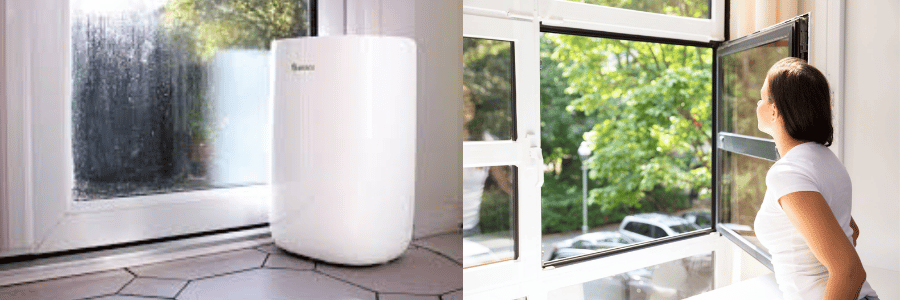
7. Prevent Mold and Mildew Growth
Persistent moisture around your windows can lead to mold and mildew growth, which can cause serious damage to window frames, walls, and your health. To prevent mold from forming:
Use Mold-Resistant Paint
If you live in a high-humidity area or have trouble with condensation around your windows, consider using mold-resistant paint on the window sills, frames, and surrounding walls. This type of paint helps prevent the growth of mold and mildew on painted surfaces.
Regular Cleaning
Keep window sills, frames, and the surrounding walls clean and dry to prevent mold and mildew from developing. Use a mild cleaning solution to wipe down the window areas and keep them free of dust and debris that can trap moisture.
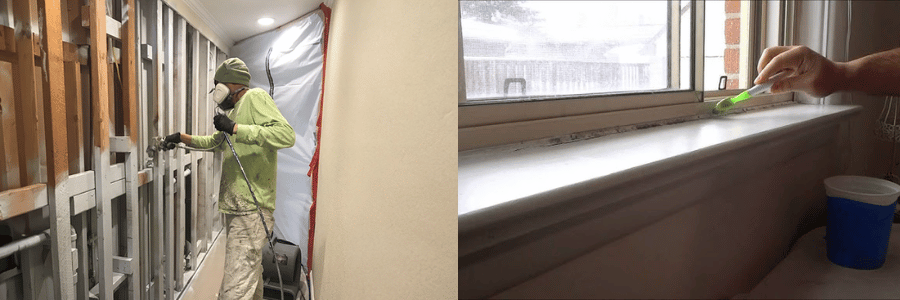
Conclusion: Keep Your Home Dry and Protected
Rain-proofing your windows is essential for protecting your home from water damage, mold growth, and reduced energy efficiency. By choosing the right window materials, ensuring proper sealing, installing flashing, and maintaining good drainage around your windows, you can safeguard your home against the elements and extend the life of your windows.
With these best practices in place, you’ll be able to keep your home dry, comfortable, and free from the damaging effects of wet weather. Regular maintenance, along with thoughtful design and materials, will help you enjoy a well-protected home for years to come.
Rain-proofing your windows is essential for protecting your home from water damage, mold growth, and reduced energy efficiency. By choosing the right window materials, ensuring proper sealing, installing flashing, and maintaining good drainage around your windows, you can safeguard your home against the elements and extend the life of your windows.
With these best practices in place, you’ll be able to keep your home dry, comfortable, and free from the damaging effects of wet weather. Regular maintenance, along with thoughtful design and materials, will help you enjoy a well-protected home for years to come.


